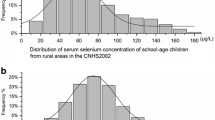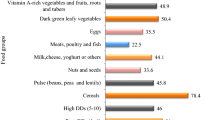Abstract
Serum copper is an insensitive but reliable biomarker reflecting the change of copper nutritional status in both depleted and replete populations. The current study aimed to establish the reference values of serum copper in school-age children and pregnant women in China and to explore the adequate range of serum copper for both these two categories of people. A multistage, stratified, random sampling combined with probability proportionate to regional size sampling method was employed. A total of 4019 subjects (2736 school-age children and 1283 pregnant women) were selected from China Nutrition and Health Survey 2010–2012 (CNHS 2010–2012). The concentration of serum copper was determined by sector field inductively coupled plasma mass spectrometry (SF-ICP-MS). The adequate range of serum copper was determined by the logistic sigmoid saturation curve of the median derivatives. The median concentration of serum copper was 1140.9 μg/L with a range of 746.7–1677.6 μg/L for school-age children and 1933.4 μg/L with a range of 947.4–3391.4 μg/L for pregnant women. The adequate range of serum copper was 905.7–1440.7 μg/L for school-age children and 1308.8–2537.8 μg/L for pregnant women. These parameters represent an essential prerequisite for the assessment of copper nutritional status, as well as nutrition interventions.


Similar content being viewed by others
References
Madsen E, Gitlin JD (2007) Copper and iron disorders of the brain. Annu Rev Neurosci 30:317–337
Bertinato J, L’Abbé MR (2004) Maintaining copper homeostasis: regulation of copper-trafficking proteins in response to copper deficiency or overload. J Nutr Biochem 15:316–322
Uauy R, Olivares M, Gonzalez M (1998) Essentiality of copper in humans. Am J Clin Nutr 67:952–959
Romana DL, Olivares M, Uauy R, Araya M (2011) Risks and benefits of copper in light of new insights of copper homeostasis. J Trace Elem Med Bio 25(1):3–13
Olivares M, Méndez MA, Astudillo PA, Pizarro F (2008) Present situation of biomarkers for copper status. Am J Clin Nutr 88:859–862
Harvey LJ, McArdle HJ (2008) Biomarkers of copper status: a brief update. Brit J Nutr 99(S3):10–13
Harvey LJ, Ashton K, Hooper L, Casgrain F-TSJ (2009) Methods of assessment of copper status in humans: a systematic review. Am J Clin Nutr 89:2009–2024
Lutsenko S, Bhattacharjee A, Hubbard AL (2010) Copper handling machinery of the brain. Metallomics 2:596–608
Keen CL, Uriu-Hare JY, Hawk SN, Jankowski MA, Daston GP, Kwik-Uribe CL, Rucker RB (1998) Effect of copper deficiency on prenatal development and pregnancy outcome. Am J Clin Nutr 67:1003–1011
Álvarez SI, Castañón SG, Ruata MLC, Aragüés EF, Terraz PB, Irazabal YG, González EG, Rodríguez BG (2007) Updating of normal levels of copper, zinc and selenium in serum of pregnant women. J Trace Elem Med Biol 21:49–52
Arvanitidou V, Voskaki I, Tripsianis G, Athanasopoulou H, Tsalkidis A, Filippidis S, Schulpis K, Androulakis I (2007) Serum copper and zinc concentrations in healthy children aged 3–14 years in Greece. Biol Trace Elem Res 115:1–12
Schneider JM, Fujii ML, Lamp CL, Lönnerdal B, Zidenberg-Cherr S (2007) The prevalence of low serum zinc and copper levels and dietary habits associated with serum zinc and copper in 12- to 36-month-old children from low-income families at risk for iron deficiency. J Am Diet Assoc 107:1924–1929
Morales-Ruán M, Villalpando S, García-Guerra A et al (2012) Iron, zinc, copper and magnesium nutritional status in Mexican children aged 1 to 11 years. Salud Publ Mex 54:125–134
Pathak P, Kapil U, Kapoor SK, Saxena R, Kumar A, Gupta N, Dwivedi SN, Singh R, Singh P (2004) Prevalence of multiple micronutrient deficiencies amongst pregnant women in a rural area of Haryana. Indian J Pediatr 71:1007–1014
Association WM (2001) World Medical Association Declaration of Helsinki. Ethical principles for medical research involving human subjects. B World Health Organ 79:373
Organization WH (1995) Physical status: the use and interpretation of anthropometry: report of a WHO Expert Committee. WHO technical report series, Geneva, p 854
Mark A, Klebanoff M, Shiono P, Selby JV, Tracjtenberg AJ, Graubard BI (1990) Institute of Medicine, Nutrition during pregnancy. National Academy Press, W: D: C
Prejac J, Višnjević V, Drmić S, Skalny AA, Mimica N, Momčilović B (2014) A novel concept to derive iodine status of human populations from frequency distribution properties of a hair iodine concentration. J Trace Elem Med Biol 28:205–211
Lin C-N, Wilson A, Church BB, Ehman S, Roberts WL, McMillin GA (2012) Pediatric reference intervals for serum copper and zinc. Clin Chim Acta 413:612–615
Abou-Shady O, El Raziky MS, Zaki MM, Mohamed RK (2011) Impact of Giardia lamblia on growth, serum levels of zinc, copper, and iron in Egyptian children. Biol Trace Elem Res 140:1–6
Voskaki I, Arvanitidou V, Athanasopoulou H, Tzagkaraki A, Tripsianis G, Giannoulia-Karantana A (2010) Serum copper and zinc levels in healthy Greek children and their parents. Biol Trace Elem Res 134:136–145
Rükgauer M, Klein J, Kruse-Jarres J (1997) Reference values for the trace elements copper, manganese, selenium, and zinc in the serum/plasma of children, adolescents, and adults. J Trace Elem Med Biol 11:92–98
Perrone L, Gialanella G, Moro R, Feng SL, Boccia E, Palombo G, Carbone MT, Toro RD (1998) Zinc, copper, and iron in obese children and adolescents. Nutr Res 18:183–189
Amare B, Moges B, Fantahun B, Tafess K, Woldeyohannes D, Yismau G, Ayane T, Yabutani T, Mulu A, Ota F, Kassu A (2012) Micronutrient levels and nutritional status of school children living in Northwest Ethiopia. Nutr J 11:108
Lima S, Arrais R, Sales C, Almeida M, Sena M, Oloveira T, Andrade S, Pedrosa F (2006) Assessment of copper and lipid profile in obese children and adolescents. Biol Trace Elem Res 114:19–29
Bui VQ, Stein AD, DiGirolamo AM, Ramakrishnan U, Flores-Ayala RC, Ramirez-Zea M, Grant FK, Villalpando S, Martorell R (2012) Associations between serum C-reactive protein and serum zinc, ferritin, and copper in Guatemalan school children. Biol Trace Elem Res 148:154–160
Huang HM, Leung PL, Sun DZ, Zhu MG (1999) Hair and serum calcium, iron, copper, and zinc levels during normal pregnancy at three trimesters. Biol Trace Elem Res 69:111–120
Kilinc M, Coskun A, Bilge F, Imrek SS, Yl A (2010) Serum reference levels of selenium, zinc and copper in healthy pregnant women at a prenatal screening program in southeastern Mediterranean region of Turkey. J Trace Elem Med Biol 24:152–156
Awadallah S, Abu‐Elteen K, Elkarmi A, Qaraein SH, Salem NM, Mubarak MS (2004) Maternal and cord blood serum levels of zinc, copper, and iron in healthy pregnant Jordanian women. J Trace Elem Med Biol 17:1–8
Al‐Bader A, Hussain T, Al‐Mosawi M, Otaibi M, Abul H, Khalifa D, Dashti H (1997) Serum zinc and copper concentrations in pregnant women from Kuwait. J Trace Elem Med Biol 10:209–215
Zhang Z, Yuan E, Liu J, Lou XF, Jia LT, Li XF, Zhang LL (2013) Gestational age-specific reference intervals for blood copper, zinc, calcium, magnesium, iron, lead, and cadmium during normal pregnancy. Clin Biochem 46:777–780
Al-Saleh E, Nandakumaran M, Al-Harmi J, Teena S, Al-Enezi H (2006) Maternal-fetal status of copper, iron, molybdenum, selenium, and zinc in obese pregnant women in late gestation. Biol Trace Elem Res 113:113–123
O’Brien KO, Zavaleta N, Caulfield LE, Wen JP, Abrams SA (2000) Prenatal iron supplements impair zinc absorption in pregnant Peruvian women. J Nutr 130:2251–2255
Neggers Y, Goldenberg RL (2003) Some thoughts on body mass index, micronutrient intakes and pregnancy outcome. J Nutr 133:1737–1740
Acknowledgments
The authors are thankful to all the subjects who participated in this study and the work teams who joined in the Project of National Nutrition and Health Survey in China 2010–2012.
Author information
Authors and Affiliations
Corresponding author
Ethics declarations
All the procedures in the present study were approved by the Ethics Committee of the National Institute of Nutrition and Health, Chinese Center for Disease Control and Prevention.
Conflict of Interest
The authors declare that they have no competing interests.
Rights and permissions
About this article
Cite this article
Liu, X., Piao, J., Zhang, Y. et al. Serum Copper Status in School-Age Children and Pregnant Women in China Nutrition and Health Survey 2010–2012. Biol Trace Elem Res 173, 268–274 (2016). https://doi.org/10.1007/s12011-016-0639-x
Received:
Accepted:
Published:
Issue Date:
DOI: https://doi.org/10.1007/s12011-016-0639-x




